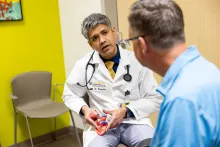Stroke: Know the basics
What is a stroke?
A stroke is much like a heart attack, except it occurs in the brain. Sometimes called a brain attack, stroke occurs when the flow of oxygen-rich blood to a portion of the brain is blocked. Brain cells start to die after a few minutes without oxygen. A stroke can cause lasting brain damage, long-term disability, or even death.
Symptoms of a stroke
There is usually no pain associated with the symptoms. They may come and go, go away totally, or get worse over the course of several hours. If the symptoms go away completely in a short time with little or no damage to the brain, the episode is typically called a transient ischemic attack (TIA). A TIA may be a warning sign of a future stroke. It's important to seek treatment for symptoms of a stroke, even if they go away.
Watch for these signs:
- Weakness in the arm or leg or both on one side of the body, ranging from total paralysis to a very numb weakness
- Weakness in the muscles of the face, resulting in face drooping or looking lopsided
- Slurred speech because the patient can’t control the movement of their lips or tongue
- Difficulty walking, balancing, or picking up objects
- Dizziness and/or loss of consciousness
- Difficulty with vision, such as double vision, loss of peripheral (side) vision, or blindness
- Sudden, severe headache different from past headaches
Not getting enough physical activity can lead to other health conditions that can raise the risk for stroke. These health conditions include obesity, high blood pressure, high cholesterol, and diabetes. Regular physical activity can lower your chances for stroke.
If you have any of these symptoms, seek medical attention immediately.
When to seek medical care
Stroke is a medical emergency. If you think you or someone else is having a stroke, immediately call 9-1-1 for an ambulance and transport to a hospital’s emergency department.
During a stroke, every minute counts. Do not delay in making a call to 9-1-1.
Types of stroke
The two main causes of strokes are ischemic and hemorrhagic and involve blood vessels in the brain.
1. Ischemic (“is-KEE-mik”) stroke
- Happens when a blood clot blocks a blood vessel in the brain
- About eight out of 10 strokes are ischemic strokes
- This is the most common type of stroke in adults
2. Hemorrhagic (“hem-ah-RAW-jick”) stroke
- Occurs when an artery in the brain leaks blood or ruptures (breaks open)
- The leaked blood puts too much pressure on brain cells, which damages them
- Less common but more deadly than ischemic strokes
Stroke diagnosis
A stroke is a serious medical condition that requires emergency care. A stroke can cause lasting brain damage, long-term disability, or even death.
Stroke is preliminarily diagnosed by healthcare providers after a medical history and physical examination is done. The exam includes looking at blood pressure and pulse, heart and lungs, and a neurologic examination.
To find out what kind of stroke it is, the doctor will do a CT scan of the brain, which can show if there is bleeding. The doctor may order other tests to find the location of the clot or bleeding, check for the amount of brain drainage, and check for other conditions that can cause symptoms similar to a stroke.
How is it treated?
If you have a stroke, prompt treatment can reduce damage to your brain and help you avoid lasting disabilities. Prompt treatment also may help prevent another stroke.
For an ischemic stroke, treatment focuses on restoring blood flow to the brain. If you get to the hospital right away after symptoms begin, doctors may use a medicine or procedure that dissolves or removes blood clots.
A hemorrhagic stroke can be hard to treat. Doctors may do surgery or other treatments to stop bleeding or reduce pressure on the brain. Medicines may be used to control blood pressure and brain swelling.
After either kind of stroke and after your condition is stable, treatment shifts to preventing complications and future strokes.
Stroke prevention
High blood pressure, high cholesterol, and smoking are leading causes of stroke. You can make some important lifestyle changes to reduce your risk of stroke and improve your overall health.
- Get your blood pressure checked and treated if it’s high. Even moderately high blood pressure over the years can lead to a stroke.
- Treat high cholesterol with diet and exercise and then medication to reduce the risk of stroke.
- Stop smoking or never smoke. Cigarette smoking can damage the heart and blood vessels, increasing your risk for stroke.
- Manage diabetes. Keep your blood sugar levels within a target range.
- If your doctor recommends taking aspirin or a blood thinner, take it.
